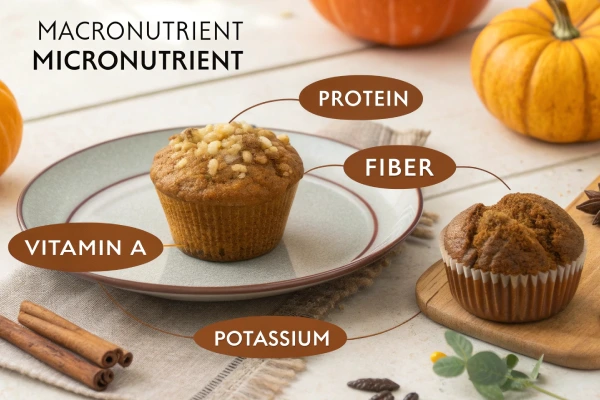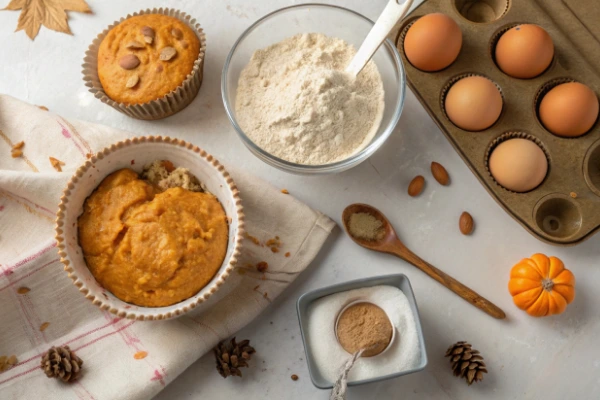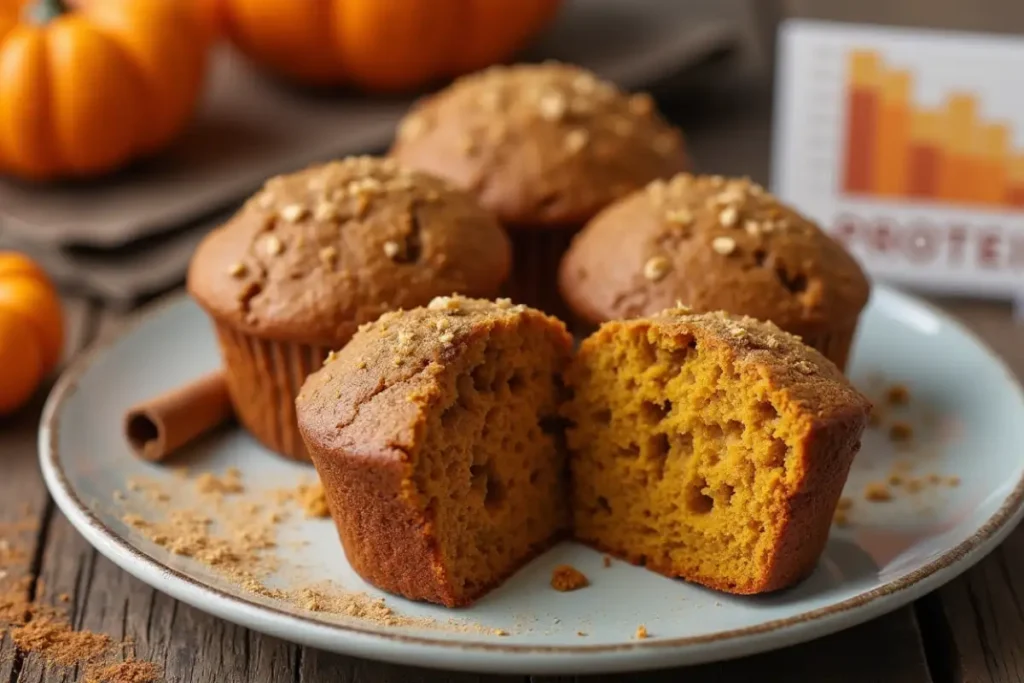Table Of Contents
Table of Contents
How much protein is in a pumpkin muffin? Muffins made from pumpkin are a beloved dessert, particularly during the autumn season. They are made with pumpkin puree, flour, spices, and sugar, creating a perfect balance between earthy and sweet flavors. These muffins can be enjoyed for breakfast or as a snack and are often appreciated for their moist texture and delicious taste. But when it comes to their nutritional profile, specifically the protein content, how much protein is in a pumpkin muffin? Let’s dive in and explore.
Nutritional Value of Pumpkin Muffins
Macronutrients Breakdown
| Nutrient | Approximate Amount (per 85 g muffin) |
|---|---|
| Calories | 180-250 |
| Carbohydrates | 30-40 grams |
| Fats | 6-12 grams |
| Protein | 2-6 grams |
Micronutrients in Pumpkin Muffins
| Nutrient | Benefit |
|---|---|
| Vitamin A | Helps maintain eye health |
| Vitamin C | Boosts immunity |
| Potassium | Helps regulate blood pressure |
| Fiber | Aids digestion |
Despite all the nutrition, pumpkin muffins usually aren’t very protein-rich, making the muffin more of a carb-based snack rather than a protein-rich option.

Protein Content in Pumpkin Muffins
Average Protein Content in Homemade Pumpkin Muffins
Pumpkin muffins made at home typically contain between 2-4 milligramEnhancing Protein in Pumpkis of protein each depending on the ingredients that are used. The majority of the protein is derived from eggs, flour, and even milk that’s added in the preparation.
Protein in Store-Bought Pumpkin Muffins
The pumpkin muffins you buy at the store may contain slightly more protein, typically around 4-6 grams–because of ingredients that are fortified or flours that are enriched. But, they can also contain more sugars or fats. This may reduce their nutritional value.
Factors Affecting Protein Levels
Ingredients Used
The amount of protein in a muffin made from pumpkin is dependent upon the particular recipe. Adding ingredients like:
- Eggs They are high in protein (6 grams for each egg).
- Greek Yogurt: Adds 10-15 grams per serving.
- Milk or plant-based protein milk: Increases protein content.
Portion Size and Baking Method
The larger muffins will naturally have more protein due to the increased amount of ingredients. However, the way that muffins are made like making use of almond flour, or even oat flour could affect the amount of protein in the muffins.
Enhancing Protein in Pumpkin Muffins
If you’re trying to make your pumpkin muffins more protein-rich there are many ways to accomplish this.
Adding Protein Powder
- Whey Protein Powder Twenty to 25 grams of protein in a scoop.
- Plant-Based Protein Powder It is suitable for vegans, with 15 to 20 grams of protein per scoop.
Mix the powder with the dry ingredients to give you a protein boost. However, mixing in protein powder may often result in dry, spongy muffins when not balanced with moisturizing ingredients. To avoid this problem, read Why are my protein muffins dry? The perfect Moist Muffins Tips from an expert on how to keep your muffins soft and fluffy.
Incorporating Nuts and Seeds
- Chia Seeds Five grams of protein for each ounce.
- Walnuts or Almonds: 6-7 grams of protein per one ounce.
- Pumpkin Seeds They naturally complement pumpkin’s flavor, while providing seven grams of protein for each 1 ounce.
Alternative Flour Options
Utilizing flour such as almond flour (6 grams per 1/4 cup) or Oat flour (4 grams per 1/4 cup) will increase protein, without affecting taste in any way. To get more ideas for making moist muffins that are balanced in nutritional value, read the steps to make moist Muffins.
If you’re looking to make protein-rich pumpkin muffins, have a glance at Protein Pumpkin Muffins A Healthy and Delicious Treat for the Fall for more recipes and helpful tips.
If you follow these tips by following these tips, it is possible to make muffins made of pumpkin that are not just more delicious, but, they are also more nutritious and richer in protein.

The Comparative Study of Pumpkin Muffins with Other Muffins
What do the pumpkin-based muffins compare with other muffins in terms of nutritional value?
| Muffin Type | Calories | Protein (g) | Carbs (g) | Fats (g) |
|---|---|---|---|---|
| Pumpkin Muffin | 200 | 3-5 | 30-40 | 8-12 |
| Blueberry Muffin | 220 | 2-4 | 35-45 | 9-13 |
| Banana Nut Muffin | 250 | 4-6 | 35-45 | 10-15 |
| Chocolate Chip Muffin | 270 | 3-4 | 40-50 | 12-18 |
It is evident that pumpkin muffins are between the lower and moderate portion of protein content, except that they are enriched.
Benefits of Protein in Diet
Protein is a macronutrient that plays an essential part in ensuring overall health. It’s frequently referred to as the”building block” of the human body because it aids in the repair of cells, muscle growth, and immune support. For those who lead an active lifestyle, getting enough protein intake is crucial.
Key Benefits of Protein:
- Recovery and Muscle Growth: Supports muscle recovery after training.
- Diet Management Makes it easier to stay fuller longer, and reduces cravings.
- Increases Metabolism Increases the rate of burning calories through the effect of heat from food.
- Enhances bone health: Provides structure and strength to bones.
- Hormone Regulation: Assists in the creation of hormones and enzymes.
Infusing the pumpkin muffins with protein can be turned into a nutritious snack that provides these benefits, without loss of flavor.
Low-Protein vs. High-Protein Pumpkin Muffins
All pumpkin muffins are not alike. Certain recipes emphasize taste while others are more focused on nutritional quality. Let’s look at the differences between high-protein and low-protein versions:
Low-Protein Pumpkin Muffins:
- Typically, you will use all-purpose flour with sugar and a few protein-rich ingredients.
- It contains 4 to 5 grams of protein in each serving.
- Ideal as a dessert snack, but not suitable for post-workout snacking.
High-Protein Pumpkin Muffins:
- Incorporate ingredients that boost protein levels, such as Greek yogurt egg yolks, protein powder, and nut flours.
- Provide 10 to 15 grams of protein per serving, which makes them ideal to replace meals or exercise recovery.
- Offer longer-lasting energy and satisfaction.
Making the switch to high-protein muffins can drastically alter their nutritional value, without compromising taste.
Recipes for High-Protein Pumpkin Muffins
Simple High-Protein Pumpkin Muffin Recipe
Ingredients:
- 1. Cup pure pumpkin
- 2 large eggs
- 1 Cup almond flour
- 1/2 cup of oat flour
- 1 scoop vanilla protein powder
- 1/4 cup maple syrup or honey
- 1 tsp of cinnamon
- 1/2 tsp nutmeg
- 1 tsp baking soda
- 1/2 tsp baking soda
- 1/2 cup Greek yogurt
- 1 cup almond milk
Instructions:
- Preheat oven to 350degF (175degC) as well as line a muffin tin using a paper liner.
- In a large mixing bowl mix eggs, pumpkin puree as well as honey along with Greek yogurt until it is smooth.
- In a different bowl, whisk the almond flour with oat flour spice powder, protein powder, baking powder, baking soda, and baking.
- Gradually add dry ingredients to wet ingredients. Stir until combined.
- Incorporate almond milk if the batter is too thick.
- Place the muffins in the cups, and cook for about 18 to 22 minutes up to the point that a toothpick emerges clean.
- Cool before serving.
Nutritional Value Per Muffin (approx. ):
- Calories: 180
- Protein: 12 grams
- Carbohydrates 20 grams
- Fats 6 grams
Vegan Protein-Packed Pumpkin Muffins
Ingredients:
- 1 cup pumpkin purée
- 1 cup of oat flour
- Half a cup of almond butter
- 1 scoop protein powder made from plant sources
- 1. Flax eggs (1 2 tablespoons flaxseed plus 3 tablespoons of water)
- 3/4 cup maple syrup
- 1 tsp vanilla extract
- 1 tsp baking soda
- 1/2 tsp baking soda
- 1 tsp of cinnamon
Instructions:
- Preheat oven to 350 degrees F (175degC).
- Mix the flaxseed with water, and let it rest for five minutes before creating an egg made of flax.
- A bowl is used to mix the pumpkin Puree with almond butter vanilla, maple syrup, and.
- Mix dry ingredients in another bowl. Gradually add them to the wet mix.
- Incorporate Flax eggs until are well.
- Pour the batter into muffin pans, and bake for 20 to 25 minutes.
Nutritional Value Per Muffin (approx. ):
- Calories: 160
- Protein: 10 grams
- Carbohydrates 18 grams
- Fats 7 grams
Caloric Considerations with Added Protein
Although adding protein to pumpkin muffins could enhance their nutritional value, however, it can also increase their calorie content. Protein powders, nuts butters, and seeds are all calorie-rich which is why it’s important to keep portions in check if the goal is to reduce calories.
Example Calorie Boosters:
- 1 tablespoon almond butter 98 calories
- Protein powder 1 scoop: 120 calories
- 1 oz pumpkin seeds: 151 calories
Being aware of these elements can allow you to make a muffin that meets your nutritional goals without overdosing on calories.
Who Can Benefit from High-Protein Pumpkin Muffins?
High-protein pumpkin muffins aren’t only for athletes or bodybuilders. They can be beneficial to a variety of people:
- Fitness Fans: Great for muscle recovery after exercise.
- Busy Professionals: Serve as a quick, nutritious breakfast or snack.
- Weight Watchers Aids in controlling cravings, and hunger.
- Vegetarians as well as Vegans: With plant-based alternatives, they can provide vital protein.
- Children and Teens: Offer a healthy alternative to sugary snacks.
Storing Protein-Packed Pumpkin Muffins
To ensure that muffins are fresh and tasty, proper storage is crucial:
- room temperature: Store in an airtight container for a maximum of 3 days.
- Refrigeration: Keeps for up to one week in a container that is sealed.
- Freezing Put ziplock bags in the freezer for 3 months. Freeze at room temperature, or in the microwave for 30 seconds before eating.
Common Mistakes in Baking Protein Muffins
Even the most experienced bakers fail in trying to increase the amount of protein in muffins.
- Overmixing Batter It results in thick rubbery muffins instead of fluffy ones.
- Utilizing too much protein Powder can dry the batter, making muffins chalky.
- not balancing wet dry and wet ingredients: Additions of proteins require additional moisture, such as milk or yogurt.
- The absence of Baking Powder, or soda: Results in muffins that don’t rise correctly.
- Disregarding taste enhancers: The addition of vanilla, cinnamon, or even nutmeg to balance the flavor when using protein powders.
FAQs About How much protein is in a pumpkin muffin
How many grams of protein are in a pumpkin muffin?
The protein content in a pumpkin muffin varies, but a typical homemade pumpkin muffin contains around 3-5 grams of protein. Adding protein powder or ingredients like Greek yogurt can increase this amount to 8-12 grams per muffin.
Are muffins a good source of protein?
Traditional muffins are not typically high in protein, but you can boost their protein content by adding protein powder, nuts, seeds, or dairy products like Greek yogurt or cottage cheese.
How much protein is in pumpkin bread?
Pumpkin bread usually contains about 3-4 grams of protein per slice. Like muffins, you can increase the protein content by incorporating protein-rich ingredients into the recipe.
How much protein is in a Dunkin’ Pumpkin muffin?
A Dunkin’ Pumpkin muffin contains approximately 5 grams of protein. While it’s a tasty treat, it’s not a significant source of protein compared to other protein-enriched options.
Conclusion
Pumpkin muffins are tasty and have a variety of snack options, however, their protein content may vary dramatically based on the ingredients used and methods of preparation. Although standard pumpkin muffins typically comprise about 2-6 grams of protein You can increase the nutritional value of your pumpkin muffins by adding protein-rich ingredients such as Greek yogurt and protein powder as well as nuts and seeds.
The high-protein pumpkin muffins don’t just taste delicious, but they also supply essential nutrients that aid in the growth of muscles, weight management, and long-lasting energy levels. When you’re in search of an easy breakfast, post-workout snack, or just a delicious and guilt-free dessert, protein-rich pumpkin muffins are an excellent option.
Utilizing the recipes and tricks provided above, you can bake your pumpkin muffins that are high in protein and are tailored to your diet. Begin to experiment today and reap the benefits of mixing flavor and nutrients in one delicious bite!
Looking for more tasty recipes and cooking inspiration? Connect with us on Facebook at Dashtasty and become part of our foodie family.



